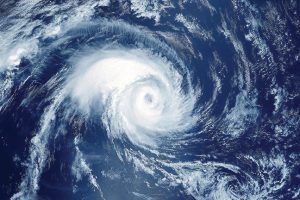Bracing for Impact

Hurricane from space. The atmospheric cyclone. Elements of this image furnished by NASA
With Ian’s and Nicole’s lingering devastation—not to mention the still-healing emotional scars and overall uncertainty they foisted on many in their paths of destructions throughout Florida—and The National Hurricane Center’s announcement last month of a reassessment that shows the mid-January area of low pressure in the Atlantic basin was actually the first storm of the 2023 Atlantic hurricane season, it might feel like there hasn’t been much of a break in atmospheric activity between this and last year.
And with the longtime La Niña—the cool phase of the El Niño-Southern Oscillation climate pattern—coming to a close as a new El Niño phase gears up, it may feel like this year’s hurricane season is punctuated by even more question marks than usual.
That transition from one pattern to another is just one element of many influencing what kind of hurricane season to expect, as well a contributing factor behind the lack of expert consensus in predictions for the 2023 Atlantic hurricane season, which formally runs from June 1 to Nov. 30, though activity does develop beyond those traditional parameters.
“In an El Niño pattern, it is typically quieter—with that said, there are a million other factors that go into a hurricane season, and that’s one of the reasons there are struggles with those seasonal forecasts,” explains Brian Shields, a meteorologist for WFTV Channel 9. “What I’m seeing is that, yes, we’re transitioning into an El Niño season, which typically can keep the numbers of named storms down, but at the same time, the water temperatures are absolutely warmer than we’ve ever seen. So there are other factors that balance that out. I don’t see a situation where we’re below-average for named storms: We’re either going to be at average or probably slightly above.”
Indeed, in early April, the University of Arizona’s forecast reflected a very active season of 19 named storms, nine hurricanes and five major hurricanes, while Colorado State University researchers predicted 13 named storms, six hurricanes and two major hurricanes. (The National Oceanic and Atmospheric Administration made its predictions after press time.)
Above-average activity exceeds the 30-year average of 14 named storms, seven hurricanes and three major ones, the latter of which is defined as a catastrophically damaging Category 3, 4 or 5 storm with sustained winds of at least 111 mph. And while the two aforementioned weather teams forecast significant deviations from that average, they did agree with Shields’ point that those much warmer Atlantic Ocean water temperatures could prompt greater storm activity, particularly if this year’s El Niño event is weaker than expected.
“We should transition into an El Niño by the end of the summer, so it’s kind of a coupling between ocean circulation and wind,” says Megan Borowski, a Florida Public Radio Emergency Network meteorologist. “We’re going to have a reversal of the trade winds with El Niño, so we’ll have warm waters developing off the coast of South America where we usually have cooler waters.”
For folks living on the East Coast, “what that can do is increase wind shear,” Borowski continues, adding that the wind speed throughout the atmosphere isn’t uniform in that “deep, deep vertical layer” of clouds. “Fingers crossed that it will kick in in time for this season, but generally what El Niño does is it will increase that vertical wind shear and it will decrease that ability for storms to organize—but that’s only one factor. There’s a lot of other global teleconnections that affect storm development.”
Keeping tabs on the myriad influencing factors at play before, during and after a hurricane develops has become a more sophisticated endeavor as weather technology advances. Even with those cutting-edge models and tools, there is still an inherent unpredictability in outguessing the weather; however, technology has proven invaluable for recognizing the patterns and measurables that initiate life-saving warnings.
“It helps in the sense that rapid intensification of storms is a big factor now, and to know how deep that warm water goes is very important because—this is just an example—a storm could go from a Category 2 to a Category 5 literally overnight, and having the tech to help be able to forecast that is important,” says Shields. “There is still more we don’t know than we know: That is the reality of Earth and everything, as far as science goes. We’re trying to learn more and more, but the tech has helped so much as far as evacuations go and helping to protect lives and property.”
No matter how helpfully advanced weather instruments become, though, having a steady, comforting and familiar human presence making those reports accessible and actionable is a critical part of a meteorologist’s role. Being that expert voice guiding their neighbors through the phases of a hurricane and keeping their audiences as informed—and able to make educated decisions about keeping themselves and their loved ones safe—as possible is a responsibility that neither Shields nor Borowski take lightly.
“It’s not all about the stats on the storm, it’s how does the storm impact you,” Shields says. “We want people to be safe as the storm’s coming. … It’s very important for me to be very clear and very slow and deliberate in passing along my message to let you know how does this impact you. The storm could have 150-mile-per-hour winds, but what does that mean for you, your home and your family? How long is it going to last? What do you need to do to stay safe?”
“All the NPR stations across the state of Florida have the ability to stream our signal … so at one point [during Hurricane Ian], the only voice out there saying what’s going on and talking about alerts, the wind warnings, the tornado warnings, was our coverage from Gainesville,” Borowski adds.
Indeed, they both tailor their delivery to the most immediately impactful message, whether it’s underscoring how important it is to reassess and update a household’s hurricane-survival kit well before stores are overrun and emotions are high, translating professional jargon into helpful directives or making survivors aware of where and how to find help in the immediate aftermath.
“You have to figure out when is the time to explain and when is the time to direct,” Borowski says. “The thing with meteorology is that you can’t ever be 100% certain with what is going to happen … but if the threat is credible and there’s a good chance we can get five feet of storm surge, people need to know that.”
As it’s still early in the Atlantic hurricane season, now is the time to ensure that you and your loved ones are as prepared as possible, when cooler heads are prevailing and a storm isn’t creeping ominously closer.
“I always encourage everybody to prepare,” says Borowski. “You know your specific needs, you know your property, you know your family. Everybody understands the intricacies of the needs within their own family unit, so assess that now. Preparing for that now when conditions are quiet gives you time to prepare when you’re not panicked, you can look at your budget, you can get everything organized now. That way, if something does threaten you, you’re ready to roll and you don’t have to have the added stress when a storm is knocking at your door.”
“Not everyone has the means to get a lot of supplies,” Shields adds. “If you can afford to get some supplies or keep old cartons and fill those with water, it helps to relieve stress and reduce anxiety to be prepared and have some supplies and food and water. It’s food and water that, if you don’t get a hurricane, you’re able to use anyway so you’re not wasting anything.”
It is tempting to let one’s guard down when predictions indicate comparatively milder activity, just as it’s important to not let above-average outlooks rob you of your peace of mind for the duration of the season. While that one devastating storm can develop at any time, not every named hurricane will unleash the full force of Mother Nature’s fury on your home.
“Fortunately, with hurricanes, we have time, so people can shelter in place at their home, or in shelters if they have evacuated,” says Shields. “But we don’t know where a storm is going to go essentially until it forms and we start tracking it. It only takes one storm to impact you—on the flip side, there could be a million storms but they all stay over the water, which would be a good thing for us.”
Hurricane Preparedness Resource Guide
GENERATOR
Genstar Generator Services
Generator Sales, Installation and Service
(407) 417-5553
OUTDOOR LIVING
MD Construction
Pool Enclosures, Screen Enclosures, Screen Room, Sunroom, Patio Covers and Lanai
(321) 663-5203
ROOFING
Total Roof Services
Full-Service Roofing & Total Roof Replacement
(407) 495-4151
Universal Roofing & Contracting
Roof Maintenance and Repairs to Comprehensive Roof Replacement
(407) 214-4URC (872)
WINDOWS & DOORS
Florida Window & Door Solutions
Quality Window & Door Replacement
(321) 203-4336
Renewal by Andersen
Patio Door Replacement and Custom Built
(855) 830-2420









